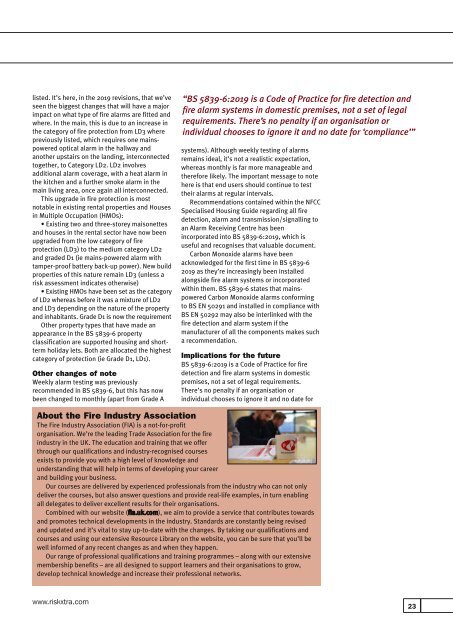RiskXtraJune2019
You also want an ePaper? Increase the reach of your titles
YUMPU automatically turns print PDFs into web optimized ePapers that Google loves.
listed. It’s here, in the 2019 revisions, that we’ve<br />
seen the biggest changes that will have a major<br />
impact on what type of fire alarms are fitted and<br />
where. In the main, this is due to an increase in<br />
the category of fire protection from LD3 where<br />
previously listed, which requires one mainspowered<br />
optical alarm in the hallway and<br />
another upstairs on the landing, interconnected<br />
together, to Category LD2. LD2 involves<br />
additional alarm coverage, with a heat alarm in<br />
the kitchen and a further smoke alarm in the<br />
main living area, once again all interconnected.<br />
This upgrade in fire protection is most<br />
notable in existing rental properties and Houses<br />
in Multiple Occupation (HMOs):<br />
• Existing two and three-storey maisonettes<br />
and houses in the rental sector have now been<br />
upgraded from the low category of fire<br />
protection (LD3) to the medium category LD2<br />
and graded D1 (ie mains-powered alarm with<br />
tamper-proof battery back-up power). New build<br />
properties of this nature remain LD3 (unless a<br />
risk assessment indicates otherwise)<br />
• Existing HMOs have been set as the category<br />
of LD2 whereas before it was a mixture of LD2<br />
and LD3 depending on the nature of the property<br />
and inhabitants. Grade D1 is now the requirement<br />
Other property types that have made an<br />
appearance in the BS 5839-6 property<br />
classification are supported housing and shortterm<br />
holiday lets. Both are allocated the highest<br />
category of protection (ie Grade D1, LD1).<br />
Other changes of note<br />
Weekly alarm testing was previously<br />
recommended in BS 5839-6, but this has now<br />
been changed to monthly (apart from Grade A<br />
“BS 5839-6:2019 is a Code of Practice for fire detection and<br />
fire alarm systems in domestic premises, not a set of legal<br />
requirements. There’s no penalty if an organisation or<br />
individual chooses to ignore it and no date for ‘compliance’”<br />
systems). Although weekly testing of alarms<br />
remains ideal, it’s not a realistic expectation,<br />
whereas monthly is far more manageable and<br />
therefore likely. The important message to note<br />
here is that end users should continue to test<br />
their alarms at regular intervals.<br />
Recommendations contained within the NFCC<br />
Specialised Housing Guide regarding all fire<br />
detection, alarm and transmission/signalling to<br />
an Alarm Receiving Centre has been<br />
incorporated into BS 5839-6:2019, which is<br />
useful and recognises that valuable document.<br />
Carbon Monoxide alarms have been<br />
acknowledged for the first time in BS 5839-6<br />
2019 as they’re increasingly been installed<br />
alongside fire alarm systems or incorporated<br />
within them. BS 5839-6 states that mainspowered<br />
Carbon Monoxide alarms conforming<br />
to BS EN 50291 and installed in compliance with<br />
BS EN 50292 may also be interlinked with the<br />
fire detection and alarm system if the<br />
manufacturer of all the components makes such<br />
a recommendation.<br />
Implications for the future<br />
BS 5839-6:2019 is a Code of Practice for fire<br />
detection and fire alarm systems in domestic<br />
premises, not a set of legal requirements.<br />
There’s no penalty if an organisation or<br />
individual chooses to ignore it and no date for<br />
About the Fire Industry Association<br />
The Fire Industry Association (FIA) is a not-for-profit<br />
organisation. We’re the leading Trade Association for the fire<br />
industry in the UK. The education and training that we offer<br />
through our qualifications and industry-recognised courses<br />
exists to provide you with a high level of knowledge and<br />
understanding that will help in terms of developing your career<br />
and building your business.<br />
Our courses are delivered by experienced professionals from the industry who can not only<br />
deliver the courses, but also answer questions and provide real-life examples, in turn enabling<br />
all delegates to deliver excellent results for their organisations.<br />
Combined with our website (fia.uk.com), we aim to provide a service that contributes towards<br />
and promotes technical developments in the industry. Standards are constantly being revised<br />
and updated and it’s vital to stay up-to-date with the changes. By taking our qualifications and<br />
courses and using our extensive Resource Library on the website, you can be sure that you’ll be<br />
well informed of any recent changes as and when they happen.<br />
Our range of professional qualifications and training programmes – along with our extensive<br />
membership benefits – are all designed to support learners and their organisations to grow,<br />
develop technical knowledge and increase their professional networks.<br />
www.riskxtra.com<br />
23
















